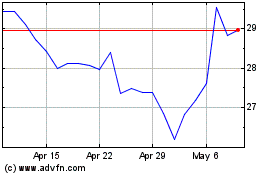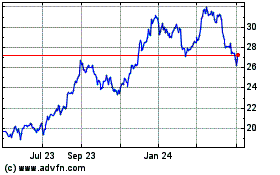At J.P. Morgan Chase & Co., pullovers may be the new
pinstripes.
In a break from tradition, the largest U.S. bank by assets is
loosening its dress code to allow employees to wear business-casual
attire on most occasions, according to an internal memo viewed by
The Wall Street Journal.
The move is relatively unusual for a Wall Street bank, where
suits are typically required for men and women due to longstanding
industry customs and the etiquette involved in dealing with wealthy
clients. It also reflects the ever-changing world of banking, where
big financial institutions are constantly evolving to stay relevant
as financial technology upstarts creep into their space.
In the memo, J.P. Morgan said the change "reflects how the way
we work is changing. More clients are dressing informally, and many
parts of our company are already business casual." It referred
employees to its "Firmwide Dress Code FAQs," which was also updated
this week, people familiar with the matter said.
The bank spelled out that athletic clothing, including
sweatpants, leggings and yoga pants, aren't acceptable, nor are
halter tops, flip-flops, hats or hoods. "Distracting, tight,
revealing or exceptionally loose or low-cut clothing," isn't
allowed either, according to a copy of the dress code viewed by The
Wall Street Journal.
But casual pants, capris, polo shirts and dress sandals are OK,
according to the dress code. Jeans and "athletic shoes" aren't
considered business casual unless communicated otherwise by the
manager, but they are often allowed in certain sites.
J.P. Morgan added that if an employee's appearance or attire
isn't acceptable according to the guidelines, then that person's
manager can ask the employee to leave, change attire or subject
that person to disciplinary action "up to and including termination
of employment."
"Business casual is not weekend casual, and if you're seeing a
client you should dress for that client," according to the
memo.
The bank's branch employees will still wear apparel from the
Chase uniform collection, but the bank has recently added more
options "that will allow our branch employees to look professional
and still be comfortable."
According to research from OfficeTeam, a unit of consultancy
Robert Half International Inc., 50% of senior managers said
employees wear less-formal clothing than they did five years ago
and 31% of office workers would prefer to be at a company with a
business-casual dress code. The most common dress-code violation?
Wearing overly casual clothing, followed by showing too much skin,
according to the survey.
The memo was sent just weeks after J.P. Morgan's management
committee, which includes Chairman and Chief Executive James Dimon,
returned from a Silicon Valley off-site meeting with many top
technology companies on cloud computing, cybersecurity and social
media. After those meetings, where the bank also analyzed fintech
companies that are trying to elbow in on some of the bank's more
important businesses, the J.P. Morgan executives felt the bank's
policy was increasingly out of step with other industries, the
person said.
Even Mr. Dimon doesn't wear a tie on many days depending on his
schedule.
J.P. Morgan has casual Fridays in many of its locations, one of
these people said, adding that some locations have tended to
already dress in business casual attire if they don't have clients
regularly entering the building.
The new policy likely won't force many employees to go shopping.
Out of its roughly 237,000 employees, more than 40,000 work in
technology and may already wear jeans to work, given that the
strictest elements of the dress code apply to those banks who deal
directly with clients.
Other Wall Street firms have had mixed success dressing
down.
In 2013, Barclays PLC began allowing casual Fridays, although
the bank stipulated that more-formal outfits were a must for "all
client and external meetings, for interviews, and for customer and
client-facing areas."
The bank last year adjusted the policy, spelling out no
flip-flops are ever allowed, among other changes.
Some banks have moved in the more formal direction. In 2010, UBS
Group AG sent some of its Swiss retail banking staff a 43-page code
giving guidelines on how to impress customers with a polished
appearance. The move was part of a test UBS is carrying out in
Switzerland across five pilot retail branches. The bank at the time
wrote that its retail banking staff should wear suits in dark gray,
black or navy blue, since these colors "symbolize competence,
formalism and sobriety."
"Light makeup consisting of foundation, mascara and discreet
lipstick…will enhance your personality," the code said, while
advising women not to wear black nail polish and nail art.
The bank has since ended that pilot, a person familiar with the
matter said.
Ben Eisen contributed to this article.
Write to Emily Glazer at emily.glazer@wsj.com
(END) Dow Jones Newswires
June 03, 2016 14:45 ET (18:45 GMT)
Copyright (c) 2016 Dow Jones & Company, Inc.
UBS (NYSE:UBS)
Historical Stock Chart
From Mar 2024 to Apr 2024

UBS (NYSE:UBS)
Historical Stock Chart
From Apr 2023 to Apr 2024
